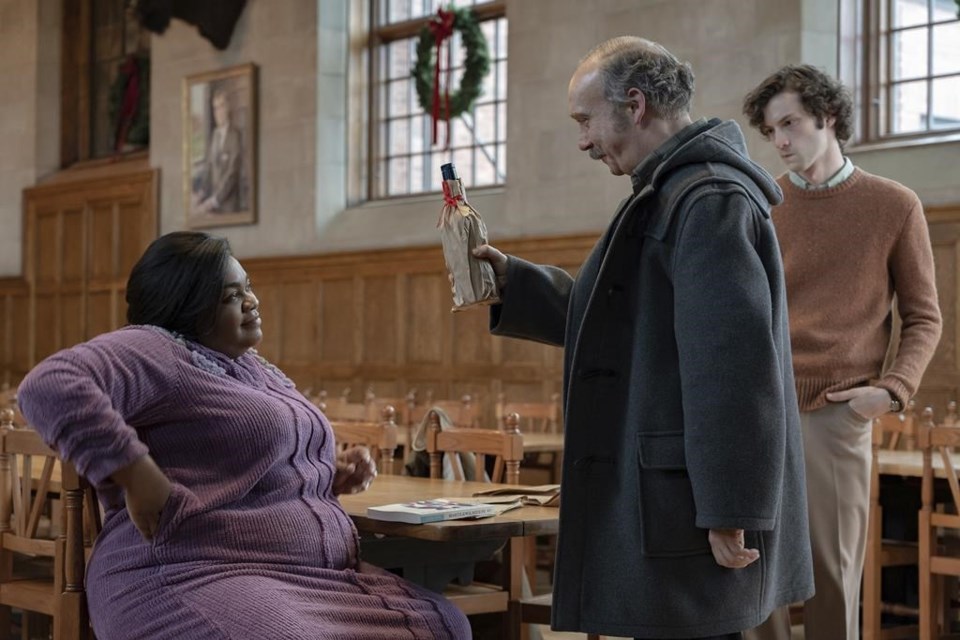Alexander Payne brings audiences to a New England boarding school in 1970 in “ The Holdovers,” a textured, nostalgic and often funny piece about three lonely and mismatched souls stuck together over Christmas break. It’s a keeper and possibly even destined to become a classic.
The holiday movie genre is suspect — even the most well-intentioned entries can be too saccharine, too wistful, too “Lifetime.” But Payne, working with a sharp script written by David Hemingston, keeps “The Holdovers” grounded and real. Even absent your own memories of smoking indoors or handsewn outerwear, this is the kind of thoughtful, precisely constructed movie where you can almost taste the cigarette smoke and feel your fingers numbing through drafty wool mittens.
With its knowingly retro production titles starting the film, “The Holdovers” lets you settle in and submit to something that could very well have been made in the time it was set, which was one of Payne's goals. Similarly, the recurring Damien Jurado song “ Silver Joy, ” a soothing and melancholy tune that perfectly sets the tone and place, feels like a forgotten Cat Stevens melody — not something from the past decade. It’s all part of the transportive magic of the experience.
Paul Giamatti stars as Paul Hunham, a curmudgeonly ancient history instructor whose only pleasure seems to be derived from holding his privileged students to account and failing them without regard for political considerations. He’s the kind of guy who looks suspiciously at a smiling colleague giving him homemade Christmas cookies and wants to start a new lesson in the last hours before the break.
Paul draws the short straw for holdover duty — i.e. babysitting the students staying on campus during the break for various reasons. After a few days of chaos and humor, the group is whittled down to just one: Angus Tully (newcomer Dominic Sessa), whose mom abandoned their plans for a beach vacation at the last minute to spend time with her new husband. And no one is happy, least of all Mary Lamb (Da’Vine Joy Randolph), the head cook mourning her son’s death in Vietnam.
The actors get to explore depths beyond the tropes of the cranky teacher, the depressed cook and the privileged jerk as they clumsily try to navigate an unpleasant situation. To make matters even bleaker, food deliveries stop over the break and the heat is turned off everywhere but the infirmary, where they must bunk in sad hospital beds for the duration.
It’s strange to think that this is the first time that Giamatti has reunited with Payne since screaming about not wanting Merlot in “Sideways,” which came out almost 20 years ago. These two together make for a special match. Giamatti doesn’t let the characters’ quirks (a glass eye) overwhelm his choices — this man’s pathos runs deep, as does his militant view of what a Barton man does and does not do.
Randolph also adds turbulent emotion to what could have been a tertiary, one-note character consumed in grief. She is in grief, which comes on in both expected and unexpected ways, but she’s also witty and wise and a perfect foil to Paul’s didactics.
But the true discovery is Sessa, making his film debut. They found him in the drama department at one of their shooting locations, Deerfield Academy. Casting modern teens in period pieces can be a tricky art, but Sessa somehow looks straight out of 1969. And he goes head-to-head with his seasoned co-stars, exhibiting a real capacity for both drama and physical comedy.
The idea of found family is a little too neat and cliche for “The Holdovers,” but perhaps more resonant and believable are the hard, and sometimes comically, learned lessons about how to be a decent person in the world — how to look outside of your own problems to empathize with and maybe even help others. No one comes out of this fixed or healed; It’s just a bit of life mixed up in the surreal pressure cooker of the holidays.
“The Holdovers,” a Focus Features release opening in New York and Los Angeles Friday, in limited release Nov. 3, nationwide on Nov. 10, is rated R by the Motion Picture Association for “some drug use, language and brief sexual material.” Running time: 133 minutes. Three and a half stars out of four.
Lindsey Bahr, The Associated Press


